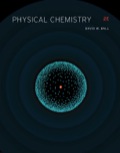
Physical Chemistry
2nd Edition
ISBN: 9781285969770
Author: Ball
Publisher: Cengage
expand_more
expand_more
format_list_bulleted
Question
Chapter 21, Problem 21.59E
Interpretation Introduction
Interpretation:
The defect caused by the hydrogen molecules in the solid Pd metal is to be predicted. The reason as to why hydrogen is absorbed by Pd and no other gas is to be stated.
Concept introduction:
There are two types of defects possible when additional atom is present in the unit cell. When the additional atom squeezes itself between the normally occupied positions, the defect is known as the interstitial defect and when the additional atom substitutes an atom in the unit cell then it is known as the substitution defect.
Expert Solution & Answer
Want to see the full answer?
Check out a sample textbook solution
Students have asked these similar questions
First image: I have to show the mecanism (with arows and structures) of the reaction at the bottom. Also I have to show by mecanism why the reaction wouldn't work if the alcohol was primary
Second image: I have to show the mecanism (with arrows and structures) for the reaction on the left, where the alcohol A is added fast in one portion
its not an exam
what is the skeletal structure of a tertiary alkyl fluoride with six carbon atoms and no rings.
One step of glycolysis is a retro-aldol reaction (aldolase) to produce ATP.Below is the aldol reaction of the equilibrium. Show the mechanism for the base catalyzed reaction. *see image
Chapter 21 Solutions
Physical Chemistry
Ch. 21 - Prob. 21.1ECh. 21 - Boron nitride, BN, is a very hard material, harder...Ch. 21 - Prob. 21.3ECh. 21 - Prob. 21.4ECh. 21 - Figure 21.35 shows a unit cell of diamond....Ch. 21 - Prob. 21.6ECh. 21 - How many different unit cells can a crystal have...Ch. 21 - Prob. 21.8ECh. 21 - Prob. 21.9ECh. 21 - Prob. 21.10E
Ch. 21 - Prob. 21.11ECh. 21 - Prob. 21.12ECh. 21 - Prob. 21.13ECh. 21 - Prob. 21.14ECh. 21 - Prob. 21.15ECh. 21 - Prob. 21.16ECh. 21 - Prob. 21.17ECh. 21 - Prob. 21.18ECh. 21 - Prob. 21.19ECh. 21 - Prob. 21.20ECh. 21 - Prob. 21.21ECh. 21 - Prob. 21.22ECh. 21 - Prob. 21.23ECh. 21 - Prob. 21.24ECh. 21 - Prob. 21.25ECh. 21 - Prob. 21.26ECh. 21 - Prob. 21.27ECh. 21 - Prob. 21.28ECh. 21 - For a simple cubic lattice, what is the ratio of...Ch. 21 - Prob. 21.30ECh. 21 - Prob. 21.31ECh. 21 - Consider Figure 21.21. If the lower rightmost...Ch. 21 - Prob. 21.33ECh. 21 - The aluminum-nickel alloy AlNi has a simple cubic...Ch. 21 - Prob. 21.35ECh. 21 - The first two signals from a powdered sample has X...Ch. 21 - Prob. 21.37ECh. 21 - Prob. 21.38ECh. 21 - Prob. 21.39ECh. 21 - Prob. 21.40ECh. 21 - Prob. 21.41ECh. 21 - Prob. 21.42ECh. 21 - Prob. 21.43ECh. 21 - Prob. 21.44ECh. 21 - Prob. 21.45ECh. 21 - What is the coordination number in the cesium...Ch. 21 - Prob. 21.47ECh. 21 - Which solid phase that is, which allotrope of...Ch. 21 - Prob. 21.49ECh. 21 - Prob. 21.50ECh. 21 - Write Born-Haber cycles showing the relationship...Ch. 21 - Prob. 21.52ECh. 21 - Prob. 21.53ECh. 21 - Prob. 21.54ECh. 21 - The lattice energy for potassium iodide, KI, is...Ch. 21 - Prob. 21.56ECh. 21 - Prob. 21.57ECh. 21 - Prob. 21.58ECh. 21 - Prob. 21.59ECh. 21 - Prob. 21.60ECh. 21 - Prob. 21.61ECh. 21 - Prob. 21.62ECh. 21 - Prob. 21.63ECh. 21 - Prob. 21.64E
Knowledge Booster
Similar questions
- Draw the mechanism (including all curved arrows for electron movement) showing how the maleicanhydride is attacked by the anthracene and formation of the final Diels Alder product.arrow_forwardProvide the missing information. *see imagearrow_forwardProvide the missing information. *see imagearrow_forward
- Provide the missing information. *see imagearrow_forwardI have a bottle of butanal that has been improperly used by lab workers. They allowed a traceamount NaOH (aq) to contaminate the bottle. What is now in my bottle of “butanal? What is the molecular name and functional group name? Draw the structure.arrow_forwardProvide the missing information. *see imagearrow_forward
arrow_back_ios
SEE MORE QUESTIONS
arrow_forward_ios
Recommended textbooks for you
 Principles of Modern ChemistryChemistryISBN:9781305079113Author:David W. Oxtoby, H. Pat Gillis, Laurie J. ButlerPublisher:Cengage Learning
Principles of Modern ChemistryChemistryISBN:9781305079113Author:David W. Oxtoby, H. Pat Gillis, Laurie J. ButlerPublisher:Cengage Learning ChemistryChemistryISBN:9781305957404Author:Steven S. Zumdahl, Susan A. Zumdahl, Donald J. DeCostePublisher:Cengage Learning
ChemistryChemistryISBN:9781305957404Author:Steven S. Zumdahl, Susan A. Zumdahl, Donald J. DeCostePublisher:Cengage Learning Chemistry: An Atoms First ApproachChemistryISBN:9781305079243Author:Steven S. Zumdahl, Susan A. ZumdahlPublisher:Cengage Learning
Chemistry: An Atoms First ApproachChemistryISBN:9781305079243Author:Steven S. Zumdahl, Susan A. ZumdahlPublisher:Cengage Learning
 Chemistry: Principles and PracticeChemistryISBN:9780534420123Author:Daniel L. Reger, Scott R. Goode, David W. Ball, Edward MercerPublisher:Cengage Learning
Chemistry: Principles and PracticeChemistryISBN:9780534420123Author:Daniel L. Reger, Scott R. Goode, David W. Ball, Edward MercerPublisher:Cengage Learning Chemistry for Engineering StudentsChemistryISBN:9781337398909Author:Lawrence S. Brown, Tom HolmePublisher:Cengage Learning
Chemistry for Engineering StudentsChemistryISBN:9781337398909Author:Lawrence S. Brown, Tom HolmePublisher:Cengage Learning

Principles of Modern Chemistry
Chemistry
ISBN:9781305079113
Author:David W. Oxtoby, H. Pat Gillis, Laurie J. Butler
Publisher:Cengage Learning

Chemistry
Chemistry
ISBN:9781305957404
Author:Steven S. Zumdahl, Susan A. Zumdahl, Donald J. DeCoste
Publisher:Cengage Learning

Chemistry: An Atoms First Approach
Chemistry
ISBN:9781305079243
Author:Steven S. Zumdahl, Susan A. Zumdahl
Publisher:Cengage Learning


Chemistry: Principles and Practice
Chemistry
ISBN:9780534420123
Author:Daniel L. Reger, Scott R. Goode, David W. Ball, Edward Mercer
Publisher:Cengage Learning

Chemistry for Engineering Students
Chemistry
ISBN:9781337398909
Author:Lawrence S. Brown, Tom Holme
Publisher:Cengage Learning